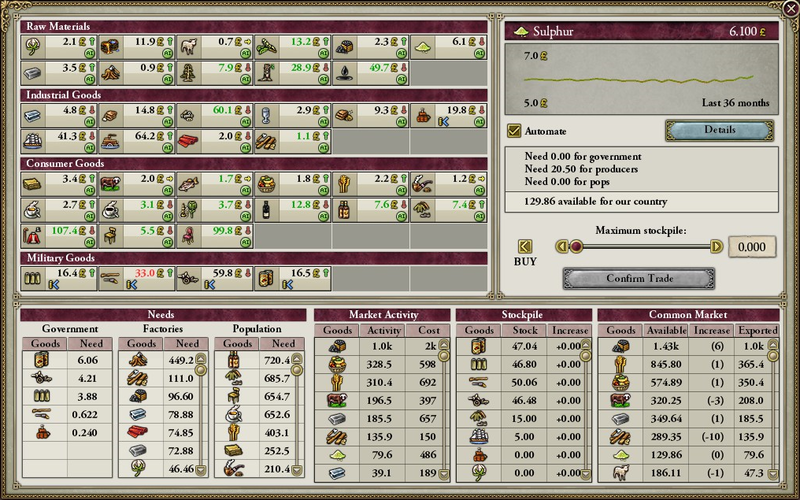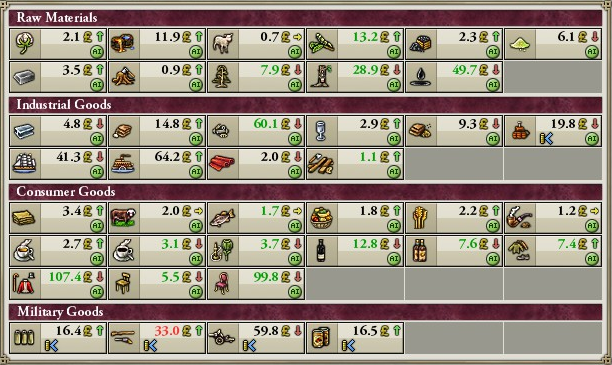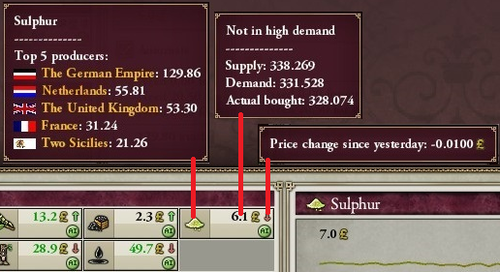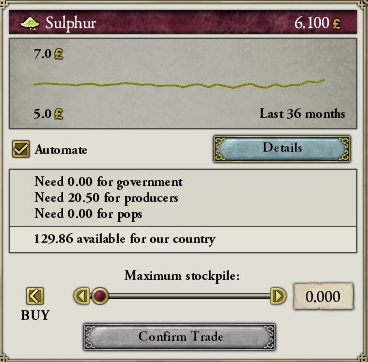无编辑摘要 |
|||
| 第1行: | 第1行: | ||
{{Version|Heart of Darkness}} | {{Version|Heart of Darkness}} | ||
[[File:Trade_screen.png|800px|thumb|right|Trade Screen]] | [[File:Trade_screen.png|800px|thumb|right|Trade Screen]] | ||
''' | 《[[维多利亚2]]》中的''' 贸易''' 是由人工智能进行的,可以根据在国内市场和世界市场上交换的商品数量来定义。来自[[ 资源生产作业]] 和[[ 工厂]] 、[[ 手工业者]] 的商品首先在国内市场出售,能够承担其费用的[[ 人群]] 以及将这些材料转化为高价值产品的工厂将会消费这些商品。 | ||
如果该国是[[ 列强]] ,或者是处于列强[[ 势力范围]] 内的非列强,未在国内市场上销售的剩余商品随后出售给同一势力范围(有时称为“势力圈”)内其他国家的市场。 | |||
世界市场只购买有需求的商品。“如果只有90% 的商品需求,那么只有90% 的商品被购买,剩下的10% 在这个系统中消失掉,所有的生产商只得到他们本该得到的90% 的钱。这意味着,当供应大于需求时,效率较低的生产商将被迫永远退出该市场。市场并不自行购买商品,它只是充当商品的结算所(它应该这样做)。<ref>[http://forum.paradoxplaza.com/forum/showthread.php?467524-Developer-Diary-17-%96-The-World-Market-and-Buying Paradox forum] Developer Diary 17 : The World Market and Buying, posted on 24 March 2010.</ref> ” | |||
== Trade order == | == Trade order == | ||
2020年10月10日 (六) 06:07的版本
《维多利亚2》中的贸易是由人工智能进行的,可以根据在国内市场和世界市场上交换的商品数量来定义。来自资源生产作业和工厂、手工业者的商品首先在国内市场出售,能够承担其费用的人群以及将这些材料转化为高价值产品的工厂将会消费这些商品。
如果该国是列强,或者是处于列强势力范围内的非列强,未在国内市场上销售的剩余商品随后出售给同一势力范围(有时称为“势力圈”)内其他国家的市场。
世界市场只购买有需求的商品。“如果只有90%的商品需求,那么只有90%的商品被购买,剩下的10%在这个系统中消失掉,所有的生产商只得到他们本该得到的90%的钱。这意味着,当供应大于需求时,效率较低的生产商将被迫永远退出该市场。市场并不自行购买商品,它只是充当商品的结算所(它应该这样做)。[1]”
Trade order
Whenever a POP, Factory or Government has a need, it will first try to satisfy that need in the Common Market. If there is no way to meet the Demand on the Common Market, then they will try to buy from the World Market instead. Access to the world market is regulated by each nation's overall rank[2], therefore the nation with the highest rank buys first, then the second highest and so on. If an item is in high demand, it is possible that nations with lower rankings will not have anything left to buy when their turn comes (this is common early on in the game with clipper convoys, for example, making it hard for an unciv to build or supply a navy).
If any country is part of another country’s Sphere of Influence, its national market is joined with its master country and all other members of that Sphere of Influence, making a larger and more versatile Common Market. In this case, tariffs do not apply to trades between nations within the same sphere of influence[3]. Therefore, sphering a nation that provides most of the imports to a Great Power might be counterproductive to the overall economy of the sphere of influence. For example, sphering China could lead to sphere of influence market saturation because of its products entering the sphere of influence market and directly competing with local production. On the other hand, sphering a nation that produces goods in high demand would give direct access to these goods, removing the need to buy them on the world market. For example, Great Britain has most dye RGOs in her sphere of influence and her fabric factories buy dye directly from them, without accessing the world market.
Price changing
Pricing of goods depends on its overall Supply, relative to its Demand.
- If goods are overproduced, then price decreases with constant speed 0.01 per day until it reaches default_price*0.22 and then price is frozen. If it is RGO only goods, the producers will quickly reduce production until supply matches demand and price is about default_price ± 0.1.
- If there is lack of goods, then price increases with constant speed of 0.01 per day until it reaches default_price*5 and then price is frozen.
Trade screen
The trade screen can be divided into three sections. In top left you have all the goods that are in the game along with their current price. Top right you have a detailed view of the good that is selected and in the bottom of the screen you have four different tables showing additional information relating to trade. Let's go over these one by one.
Left side
So in the top left we can see all the goods that are in the game divided into four categories:
- Raw Materials: Goods that are produced by RGOs.
- Industrial Goods: Goods that are produced by artisans and factories.
- Consumer Goods: Goods that are mostly used by pops. This includes both RGO produced goods like cattle and fish, as well as artisan/factory produced goods like liquor and clothes.
- Military Goods: Goods that are mostly used by governments for military units and forts.
Note that not all goods are present here at the start of the game. Goods like radio or aeroplanes only become visible here once you research the appropriate techs.
Next to each trade good you can see some info about them:
- The current price of the good.
- A little arrow next to the price(this indicates how the price has changed since yesterday).
- A green circle with the word AI written in it(this indicates that the trading of this good is currently automated).
- A stack of coins with a blue "lesser than" sign next to it(this indicates that the good is currently being bought into your stockpile).
You can also see in the screenshot that some of the prices are in different colors(black, red or green). This indicates how close the price is to the base price. If the price is more than 10% above the base price, it will be green. If it's more than 10% bellow base price, it's red. If it's within +-10% of the base price, it's black.
You can also hover your mouse over the trade goods to get more info on them. Look at the screenshot on the right. This shows the three different tooltips that are available:
- If you hover over the good icon you can see the top 5 producers in the world and how much they produce.
- If you hover over the price you can see the global supply, demand and "actual bought" of that good. Note that the "actual bought" can be different than demand since not everybody who wants that good can necessarily afford it.
- If you hover over the arrow you can see how much the price has changed since yesterday.
If you click a trade good it will be selected and will show additional info on the right side of the trade screen. If on the other hand you click the good icon, it will open the production window for that good.
Right side
When you click on a trade good it is selected and you can now see more detailed info about it on the right side of the trade screen. Here you can see:
- The exact price of the good and how it has evolved in the last 36 months.
- The automate checkbox. While this is checked the computer will handle the buying and selling of this good. Unchecking it means that it is up to you to decide how much to buy this good. All goods are set to automate at game start.
- Details button. This will open a new window that shows more info about this good.
- Domestic demand. This is divided into three sections: "need for government", "need for producers" and "need for pops". Note that demand will often be higher than what is actually bought since pops and factories might not be able to afford it. Also the "need for producers" does not include artisans demands.
- "Available for our country". This shows the quantity of this good that you have direct access to. So in other words, it's your countries production + your spherelings production + your stockpile. This means factories/pops can usually buy more than is "available for our country" since this stat does not include goods that are in the Global Market.
- Buy/Sell slider. If you uncheck the automate checkbox, you can then use this slider to decide how much of this good you want to have in your stockpile. Click the button next to the slider to show either buy or sell, then set the amount on the slider and hit Confirm Trade. The AI will now start buying/selling that good until your stockpile reaches the desired quantity - and then stay there.
Bottom of the screen
Here we see four sections: Needs, Market Activity, Stockpile and Common Market.
Needs section shows the domestic demand of:
- Government: Goods needed for military units and buildings.
- Factories: Goods needed for you factories to work properly.
- Population: Your populations life needs, everyday needs and luxury needs.
Market Activity shows how much of that good your common market(you + your spherelings) exported(if the numbers are positive) or imported(if they are negative).
Stockpile shows how much of each good you have in your stockpile. "Increase" shows how much this has changed since yesterday.
Common Market shows how much of each good was "available" in your common market. "Increase" shows how much this has changed since yesterday. "Exported" is somewhat misleading as it's not how much was actually sold but rather means how much was available for export. So if you look at the screenshot on the right, we can see that 208.0 cattle was "exported"(available for export), but under "market activity" we can see that only 196.5 were actually sold.
External links
References
- ↑ Paradox forum Developer Diary 17 : The World Market and Buying, posted on 24 March 2010.
- ↑ podcat confirms that rank governs access to the world market
- ↑ Darkrenown on sphere and tariffs




